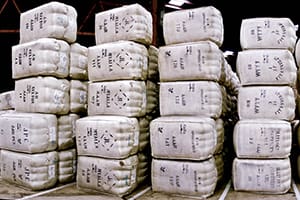 Australian wool prices surged again this week as Chinese market concern about pipeline supplies prompted activity from local traders and forward sellers.
Australian wool prices surged again this week as Chinese market concern about pipeline supplies prompted activity from local traders and forward sellers.
AWEX senior market analyst Lionel Plunkett said strong support from bullish buyers pushed the AWEX-Eastern Market Indicator up 61 cents to 1373 cents.
This is despite the EMI in US dollars closing at 1061 cents, up 52 cents, with the $A-US exchange rate at US77.31 cents. The AWEX-EMI has risen 10 percent in a fortnight, and 24pc over the last eight weeks. Brokers passed in just one percent of the 25,641 bales offered.
All Merino types broader than 22 micron, all crossbred types and most of the carding wools were quoted as selling to new highs. Merino types recorded price gains of 70-90c/kg clean and a few better top making and spinners style, high strength super and ultrafine fleece types (finer than 17.5 micron) gained upwards of 125ac/clean kg, with the 15-16 micron lines most affected.
Mr Plunkett said the 22 Micron Price Guide in Melbourne overtook its previous AWEX/AWC record (since 1979), surging to 1475 cents, with selected lots on Thursday selling at more than 1500 cents clean.
Local traders and forward sellers led charge
In Australian Wool Innovation’s weekly wool market report, trade consultant Scott Carmody said a difference in auction operations this week was that the local traders and forward sellers led the charge.
“The Chinese indent operators remained keen and active, but they were not pushing as hard as they have been the previous weeks.
“The majority of wools were still purchased for Chinese interests and orders,” he said.
“Whilst it is acknowledged the current refilling of the wool pipeline with greasy stocks is a significant driving force behind the current strong market, the widely reported reasoning of a shortfall in supply is being questioned by many export trade operators.
“Australian wool auctions this season have offered almost 7pc more bales than last year and the AWTA Key Test Data is showing an increase of total weight of wool tested of nearly 2pc, or 6.3 million kgs, at the end of May compared to the same period of the season last year,” Mr Carmody said.
“When isolating just Australian wool in a simplistic supply versus demand evaluation, and given the above supply facts, demand for the raw wool product has seemingly been given a major boost.”
Have wool prices reached new sustainable levels?
Mr Carmody said the last time the AWEX-EMI was around A1370 cents the EMI in US dollars was 1400 cents.
“Today the US-EMI is at US1061 cents and when 75-80 percent of the clip is bought on US dollars …. Maybe it is not too bad at US1061 cents.
“It sort of gives a little bit of hope that maybe this is the new price level as the Australian dollar hangs around US75-80 cents,” he said.
“This just might give hope to woolgrowers that this might be a sustainable (price) level for the short to medium term.”
He said a fully firm market is expected next week, “with possibly a few holes starting to appear as urgent requirements are filled.”
Not enough wool in processing pipeline
After a recent trip to China, including the latest IWTO conference, Australian Wool Network managing director John Colley said there was just not enough wool in the processing pipeline at the greasy, tops, yarn or cloth stages.
“There is a high demand and it is mainly in the knitwear area,” he said.
“Demand for carding wools – the pieces, the bellies, the crutchings – is high because of increased sales in knitwear right across the board everywhere, worldwide.
“But China domestic consumption is up considerably, so that side of it is extremely strong and there is such a lack of supply.”
Bale offering smallest in 12 months
Mr Plunkett said the bale offering in Australia this week was the smallest in 12 months, partly due to the seasonal patterns and Fremantle not holding an auction this week.
“The market behaviour showed a familiar pattern with the price increases over each day accumulating on a strong opening hour.
“Thursday deviated from the blueprint after it spiked mid-way through the day before settling down in the last 30 minutes.”
He said the broader microns remained the focus of attention with the 20-22 micron range adding almost 100 cents for the week.
“Merino skirtings followed the fleece sector higher, although the gains were not as large.
“Most types were 40-60 cents higher.”
Crossbred and carding prices rise again
Mr Plunkett said the smallest crossbred catalogue in nine months made further inroads into record territory. The 25-28 micron range achieved the best results. Merino carding types also continued to find good support with steady increases noted each day resulting in a weekly rise of around 10 cents, he said.
“The Southern Merino Carding Indicator has run for 25 consecutive sale days without making a loss, two days short of a record rally.”
In the AWI report, Mr Carmody said as the week progressed, price gaps began to appear again for the measured characteristics of PobM (position of break in the middle) VM (vegetable matter) and Cvh, and these gaps widened towards the close of selling, as the lesser types peeled away some of the gains put on during the week, particularly for the 19 to 21 micron types.
Brokers are forecast to offer 35,723 bales next week — smallest three-centre offering in 12 months.
Sources: AWEX, AWI Wool Market Review.

HAVE YOUR SAY